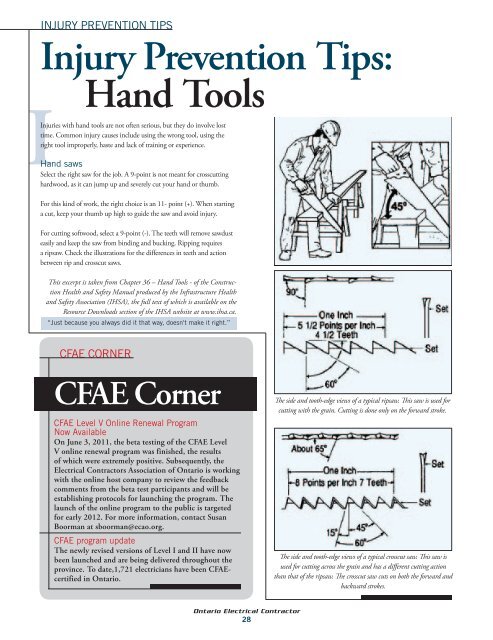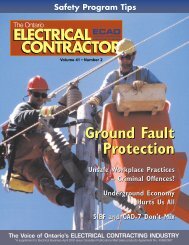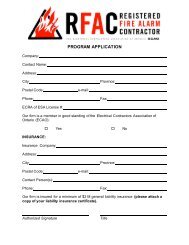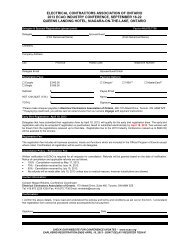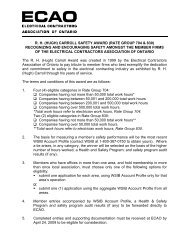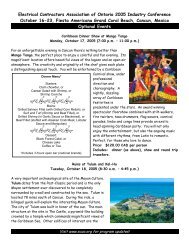Prompt Payment Legislation - Electrical Contractors Association of ...
Prompt Payment Legislation - Electrical Contractors Association of ...
Prompt Payment Legislation - Electrical Contractors Association of ...
- No tags were found...
Create successful ePaper yourself
Turn your PDF publications into a flip-book with our unique Google optimized e-Paper software.
Injury Prevention TipsInjury Prevention Tips:Hand ToolsInjuries with hand tools are not <strong>of</strong>ten serious, but they do involve losttime. Common injury causes include using the wrong tool, using theright tool improperly, haste and lack <strong>of</strong> training or experience.Hand sawsSelect the right saw for the job. A 9-point is not meant for crosscuttinghardwood, as it can jump up and severely cut your hand or thumb.For this kind <strong>of</strong> work, the right choice is an 11- point (+). When startinga cut, keep your thumb up high to guide the saw and avoid injury.For cutting s<strong>of</strong>twood, select a 9-point (-). The teeth will remove sawdusteasily and keep the saw from binding and bucking. Ripping requiresa ripsaw. Check the illustrations for the differences in teeth and actionbetween rip and crosscut saws.This excerpt is taken from Chapter 36 – Hand Tools - <strong>of</strong> the ConstructionHealth and Safety Manual produced by the Infrastructure Healthand Safety <strong>Association</strong> (IHSA), the full text <strong>of</strong> which is available on theResource Downloads section <strong>of</strong> the IHSA website at www.ihsa.ca.“Just because you always did it that way, doesn't make it right.”CFAE CORNERThe sideCFAEand tooth-edge viewsCorner<strong>of</strong> a typical crosscutsaw. This saw is used for cutting across the grainand has a different cutting action than that <strong>of</strong> theripsaw. The crosscut saw cuts on both the forwardand backward strokes.The side side and and tooth-edge tooth-edge views <strong>of</strong> views a typical <strong>of</strong> ripsaw. a typical This ripsaw. is used forThis cutting saw with is the used grain. for Cutting cutting is done with only the on grain. the forward Cutting stroke. isdone only on the forward stroke.CFAE Level V Online Renewal ProgramNow AvailableThe side and tooth-edge views <strong>of</strong> a typical crosscutOn June 3, 2011, the beta testing <strong>of</strong> the CFAE Level saw. This saw is used for cutting across the grainV online renewal program was finished, the results and has a different cutting action than that <strong>of</strong> the<strong>of</strong> which were extremely positive. Subsequently, the ripsaw. The crosscut saw cuts on both the forward<strong>Electrical</strong> <strong>Contractors</strong> <strong>Association</strong> <strong>of</strong> Ontario is working and backward strokes.with the online host company to review the feedbackcomments from the beta test participants and will beestablishing protocols for launching the program. Thelaunch <strong>of</strong> the online program to the public is targetedfor early 2012. For more information, contact SusanBoorman at sboorman@ecao.org.CFAE program updateThe newly revised versions <strong>of</strong> Level I and II have nowbeen launched and are being delivered throughout theprovince. To date,1,721 electricians have been CFAEcertifiedin Ontario.Ontario <strong>Electrical</strong> Contractor28The side and and tooth-edge tooth-edge views views <strong>of</strong> a typical <strong>of</strong> a crosscut typical saw. crosscut This saw issaw. used This for cutting saw across is used the grain for cutting and has a across different the cutting grain actionthan and that has <strong>of</strong> a the different ripsaw. The cutting crosscut action saw cuts than on both that the <strong>of</strong> forward the andripsaw. The crosscut backward saw cuts strokes. on both the forwardand backward strokes.The side andThis saw is udone only on


